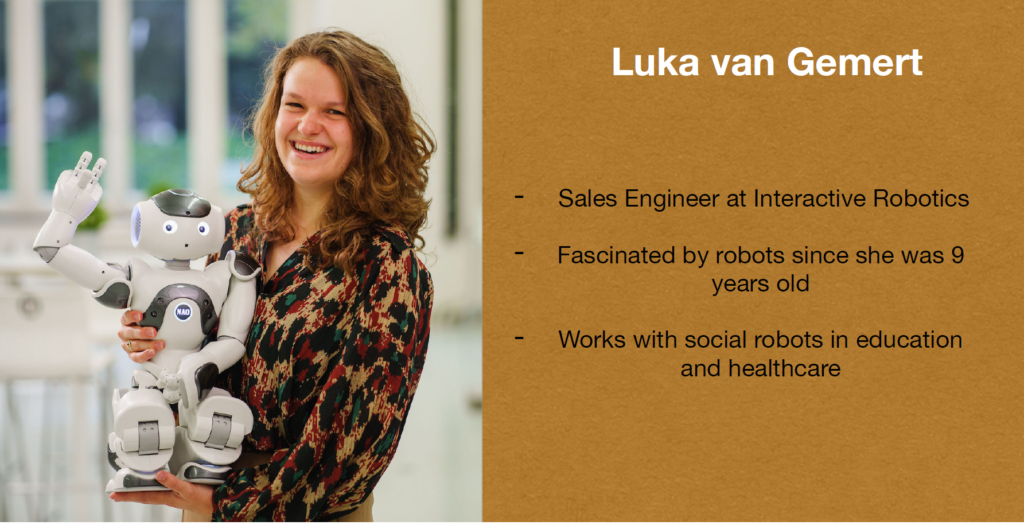
What’s your connection with robots?
I’m a big fan of robots, and my fascination with them started when I was nine years old. That’s when I first saw the NAO robot (see the photo above) when I went to a robot event in Eindhoven with my grandma. I was sitting there with my mouth wide open, watching what those robots could do, and since then, I’ve let my whole life be guided by robotics. It was no coincidence that a NAO robot was also present at the study I decided to pursue. Besides robotics, I’ve always found education and healthcare very interesting. So, when I found out about Interactive Robotics, a company that is involved in all of these fields, it was a perfect fit for me.
How would you describe your work at Interactive Robotics?
At Interactive Robotics, we focus on the effectiveness of robots in healthcare and education. We have developed a software program that makes it very easy to program a robot. This program is very accessible for children, as well as for adults without a technical background. With this, we hope to make the collaboration between humans and robots easier.
Within the company, my official job title is ‘sales engineer’, which means I deal with the technical issues within the company. Additionally, I handle the social interaction with clients, organizing feedback sessions, and giving guest lectures on programming.
Do you also create your own robots?
We don’t build our own robots, but rather purchase them. This is beneficial for us because it means we are not tied to a specific type of robot. Anything that meets our requirements for a robot can be integrated into our platform. This also makes it easier for the customer, as they can use the same software to program different robots in a user-friendly way.
How do you view the connection between humans and robots? Because we are increasingly coming into contact with (social) robots in society. That’s correct, and that’s why it’s important for people to know how to interact with this technology in a proper way. I find it interesting to observe how a robot and a human interact, because a robot and a human are not the same. We rely heavily on non-verbal communication, which is largely absent in robots. A social robot is a kind of intermediate area, as they often resemble humans more. It’s fascinating to see that people can still form a bond with a robot. It’s a bit like with a pet, people can still feel supported or connected to a robot.
At Interactive Robotics, you focus on effectively integrating robots into healthcare and education. What aspects do you consider to assess this effectiveness?
In education, for example, we look at whether a student is actually learning something from a robot and whether the robot is an additional aid in the classroom. Students often learn about
digital literacy by interacting with a robot, while also learning subjects like language or math.
Furthermore, we are heavily involved in reviewing research to see how we can support a child’s socio-emotional development through a robot. If we see from research that there is added value in
focusing on this, then we want to make that support available.
From a practical standpoint, there is sometimes concern that the use of social robots could detract from human interaction. What can you say to people who have this concern?
It is indeed true that people often wonder whether interacting with robots will diminish the personal aspect of, for example, healthcare or education. I understand that question very well, but
our approach is to offer the robot as additional support. Such a robot cannot work on its own; you can’t just place it and expect it to be ready. You still need people to make it work.
In healthcare, we let the robot handle the scheduling and act as a sort of “police officer,” so that the healthcare worker is better informed about the patient’s needs. The social aspect still lies with
the healthcare worker, who then engages in conversation with the patient. The robot is therefore supportive in this regard and actually brings back a sense of personality to healthcare.
Furthermore, people’s concerns about robots mainly stem from a lack of knowledge, which is understandable. If you don’t know what a robot can or cannot do, it’s difficult to see which tasks robots can take over from humans. It’s also challenging to trust something you are unfamiliar with. But I can assure you that interacting with a robot does not necessarily detract from social contact.
In the coming years, where do you see the biggest potential for improving the effectiveness of robots in our society?
One challenge we face is that our robots are purchased but not used for an extended period. That’s why we offer an annual license, allowing the customer to decide each year whether they
want to continue using the robot or not. In education, we often see robots being purchased out of enthusiasm, but because not all teachers know how to collaborate with the robot, it quickly ends
up in storage.
Therefore, at Interactive Robotics, we are working on supporting schools to better understand how to implement robots in education. We do this by providing workshops to make teachers proficient in using our software program. Additionally, we provide instructional videos to teachers, allowing them to access explanations about robot lessons with just a click. This way, the teacher doesn’t necessarily have to be an expert in that field.
